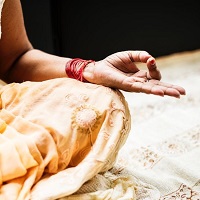
With so many styles of yoga about it can be difficult to know which is the best yoga for you. In today’s Western world we generally think of yoga in physical terms e.g. postures, stretching and good breathing techniques. We are, however, becoming more aware of the importance of the mental aspects of yoga practice, in particular meditation and mindfulness.
These aspects benefit us not only mentally, but emotionally as well – the mind and emotions are so closely linked. With regular practice, we can also begin to integrate the values of yoga into our every day lives by developing our compassion, being more grateful and selfless, and by becoming more consciously connected to all that is. When we achieve these steps, we can advance spiritually on our journey towards enlightenment.
To discover which yoga might be best for you, it’s useful to have a rough idea what you want to get out of it. Yoga can benefit us holistically, but some styles will show better results than others for weight loss or strength training for example. Whichever style you choose, make sure it’s the right level for you personally.
(See my Yoga Download Review for info on different courses suitable for anyone – you can try them for free!)
If you’re practicing from home, start gently and work up. Don’t push yourself too hard and take breaks when you need to. If you’re attending a class, let the teacher know if it’s your first time and make them aware of any health issues you have so they can make adjustments for you. Don’t overdo it – even the gentlest style of yoga can work muscles you may not even know you had!
As always, check with your doctor if you have any concerns regarding your health and undertaking a new fitness routine.
The Best Yoga For Flexibility
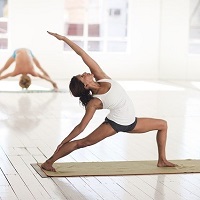
Flexibility is important for so many reasons. It can mean better athletic performance, less injury from sport or even everyday activities such as walking the dog, doing housework or putting the shopping away. Age and genetics play a part in our flexibility, but most of us can improve our current levels by following some simple steps on a regular basis.
What’s Hatha Yoga?
Hatha is one of the 6 Branches of Yoga (not to be confused with the 8 Limbs of Yoga.) Traditionally, Hatha Yoga related to the physical poses, also known as asanas. Asana translates from Sanskrit as “seat” and the first yoga poses were performed in a seated position; today they are much more varied.
Modern Hatha Yoga as a category includes many forms of yoga practices, some of the best-known styles of which are detailed below. They are termed as “Hatha” because they use a sequence of poses and breathing techniques or “pranayama” with the intention of preparing the body and mind for meditation.
Hatha Yoga as a single class, however, has a different meaning. When a class is labelled as “Hatha” you can generally expect it to be slow paced and gentle – ideal for the beginner. Hatha Yoga is a passive or restorative style, whereby the stretches are longer, allowing the body to melt into the poses by using props for support. This allows deep relaxation of the muscles.
This can be a little confusing, so if you have any doubts about what you’ve signed up for, speak to the instructor beforehand so you know exactly what the class entails.
Also known as Sun and Moon Yoga, “ha” translates as sun and “tha” as moon. At the beginning of the session the focus is on building the sun energy and the end of the session uses lunar energy to achieve balance. There may be ambient lighting and gentle background music playing to create a more meditative atmosphere.
Although Hatha Yoga classes don’t follow a set sequence, you can expect the session to open with some breathing exercises and a little meditation guided by the teacher. The best way to increase flexibility is to ensure you are warmed up before carrying out physical activity; often “Sun Salutation” poses are used as a warm up in a Hatha session. These are great for circulation, removing energy blockages and preparing the whole body for the session.
During the main part of the session, the number and difficulty of the poses will differ between levels and classes, but the poses are generally held for 5-10 breaths. These extended asanas are great for flexibility and by allowing the mind to be quiet and still during the poses, this is a good way to relax mentally.
As the session comes to an end you will hold the “Corpse Pose” for about 5 minutes in order to become grounded once more. As you might expect, for this asana you simply lay on your back and allow all of you body – and mind – to relax. This practice is carried out at the end of all yoga classes in order for the body to recover and to help it release lactic acid which is produced through exercise. It is known as “Savasana.”
By practicing regularly, say 3-4 times per week, you will really notice your flexibility improving, as well as your strength and stamina. Having said that, once a week will also bring noticeable results. Hatha Yoga is a great introduction to yoga, especially for those whose fitness levels may be on the low side.
The Best Yoga For Stress Relief
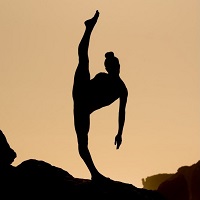
Stress can be useful in the short term and in certain situations it might even save our lives. When we are stressed, our bodies release cortisol and adrenaline which can spur us into action and give us an energy boost in times of “fight or flight.” However, long term or chronic stress can cause a seemingly never-ending list of health problems, including poor immune system, insomnia, fatigue, high blood pressure, depression and anxiety.
What’s Ashtanga Yoga?
A great yoga practice for stress relief is Ashtanga. Translated from Sanskrit as “8 limbs”, the original concept of Ashtanga related to 8 guidelines or practices on the path towards enlightenment. (See An Introduction To Yoga.) In our Western world, Ashtanga is more commonly understood to be a particular style of yoga which was introduced by Sri K. Pattabhi Jois in the 1970s.
An Ashtanga Yoga class will begin with call and response – this is where the teacher chants a “mantra” (the repetition of a word or sound), and the students respond. The purpose of this is to aid concentration, clear the room’s energy and achieve a higher level of consciousness. The opening Ashtanga mantra gives gratitude to the divine energy that connects us and to all the teachers of yoga.
Every Ashtanga class follows the same format. Next are 10 Sun Salutations, followed by a set sequence of asanas, most of which are held for 5 breaths, and all of which build heat in the body. Towards the end of the session the corpse pose or Savasana will be held for 5-10 minutes, followed by the final call and response. This closing mantra asks for peace, happiness and the protection of the earth.
There are 6 levels to Ashtanga Yoga, beginning with primary, then intermediate, followed by 4 advanced levels. The poses become more challenging with each progressive level, and you will not necessarily practice each asana within a level at once; each pose leads to the next and you will learn the next poses as you become ready.
Attention is given to our breath and how it is connected to our movements. When our breath flows more freely, so does the life force. Attention is also given to our gaze or drishti, which means “sight.” By gazing correctly, not only are we able to improve our postures, but we also achieve improved clarity mentally.
There’s no music in an Ashtanga class and no talking apart from the instructor. Some instructors are stricter than others – for example about whether you’re allowed to drink water during the session as it cools the heat you’re building. A class can be very hands on with the teacher “assisting” you into poses by means of pulling, pushing or sitting on you! Ashtanga Yoga isn’t for the faint-hearted so speak to an instructor before signing up to find out if it’s for you – especially if you’re completely new to yoga.
Sessions usually last for about 90 minutes, can be extremely challenging and require patience and persistence. If you enjoy pushing yourself physically and are a fan of rules and routine, you might just love this style. If so, you will no doubt find Ashtanga to be a great antidote to stress as the demanding physical aspects encourage the body to release more feel good chemicals. In particular, endorphins and dopamine work together to reduce stress, increase motivation and reduce depression.
(Side note – Ashtanga Yoga is also sometimes called Ashtanga Vinyasa. To clarify, “Vinyasa” is defined as the movement between asanas which is carried out with controlled breathing. Both Ashtanga and Vinyasa styles of yoga link movement with breath, but a Vinyasa class does not follow a set sequence of postures. See below.)
The Best Yoga For Strength Training
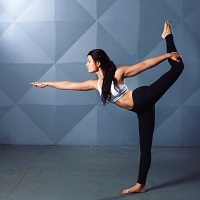
Strength training isn’t just for bodybuilding or bulking up. We all naturally lose muscle as part of the aging process. This is called “sarcopenia” and although it’s an inevitable part of life, there are measures we can take to prevent or delay it. Strength training is one of these measures. The benefits include better tone, strengthened bones, increased metabolism and higher energy levels.
What’s Vinyasa Yoga?
One of the best known and most popular yoga styles for strength training is Vinyasa Yoga. Also known as Vinyasa Flow or simply Flow, great emphasis is put upon the movement between poses; the transition from one asana to the next should be smooth and fluid. By likening our movements in yoga to how we move through life, there is an element of self-assessment and realisation involved in successful Vinyasa practice.
As with Ashtanga, Vinyasa is an “active” form of yoga whereby heat is generated in the body by using the muscles. By creating heat, the aim is to burn off toxins and impurities – mentally, physically, emotionally and spiritually. There is freedom to Vinyasa as there are no set moves to follow and the classes will differ greatly from teacher to teacher, so again, check first before signing up to make sure it’s for you.
The session will usually begin with a warm-up such as Sun Salutations. Within the main section, a variety of poses are held for about 15-30 seconds each. Expect a pretty high energy session, even at beginner level. As always, the class will end with Savasana, allowing the body to relax and recover.
From my personal experience, I’m not yet ready for Vinyasa! I tried different online Vinyasa classes for beginners but I found them all too challenging and sat it out quite a lot to avoid injuring myself. There wasn’t one that I managed to complete all the way through. I’m not at my fittest at the moment but I do consider myself to be in OK-ish condition, so this left me feeling somewhat disappointed and a little put off. I liked that the poses weren’t held for too long (when I was able to hold them!). I also liked the variation from class to class.
If, like me, you aren’t quite ready for the challenge of Vinyasa, my suggestion would be to give either Hatha or Yin a try first (see below) and build up from there.
The Best Yoga For Weight Loss
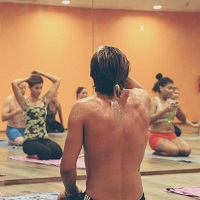
In simple terms, in order to lose weight we need to boost the metabolism and burn calories. Whereas some yoga styles involve slow stretching and a gentle workout, others can burn a good amount of calories, as well as toning the muscles which is important for looking and feeling good during and after weight loss.
In addition, awareness of the yoga principles can motivate us to be kinder and more respectful to ourselves and our bodies. By doing so, the bad habits which often lead to increased weight – unhealthy eating, excessive drinking, lack of exercise etc. – can be reduced or eliminated, thereby keeping those extra pounds off and leading to longer term better health.
What’s Bikram Yoga?
Bikram Yoga was developed by Bikram Choudhury and was bought to the West in the 1970s. Classes take place in a room heated to 105 degrees with 40% humidity. The method follows a set pattern and is taken very seriously.
Ideal for weight loss, during a class the heart rate and core temperature rise considerably. Bikram Yoga works every muscle, joint and bodily system, is an excellent way of burning fat, improving blood and lymph circulation, can aid detoxification and slow the aging process plus many other benefits.
At the beginning and end of the 90-minute session, breathing exercises are carried out in order to expand lung capacity and really get the oxygen flowing through the blood. There are 26 set poses which are each held twice and must be carried out precisely. There are mirrors in the studios to help you attain the exact pose by focusing on yourself and where you are.
During a Bikram class there are strict rules – no interactions apart from by the teacher who follows an exact script every time, you may only drink when told to do so by the teacher and you may not leave the room until the class is finished. I haven’t personally experienced Bikram Yoga, but it doesn’t sound like much fun to me.
Add to that the fact that you can’t rehydrate or leave the room for five if you’re feeling dizzy or sick due to the heat, humidity or being surrounded by sweaty bodies – I would likely give Bikram a miss if there was a class near me. If you’re so inclined, it’s possible to do Bikram at home. There are online courses available – you just need to make sure the heat is turned up to the correct temperature.
There are other forms of hot yoga, which are known as – yes, you guessed it, Hot Yoga. This is a blanket term for different yoga styles which are carried out in a hot environment, but which are NOT Bikram. Bikram Yoga is a trademark, and only those who are certified in Bikram Yoga can teach it. So, if Bikram sounds a bit too strict for you too, but you like the idea of the heat and humidity, check out what other Hot classes there are available – either near you or online.
The Best Yoga For Mental Health & Emotional Balance
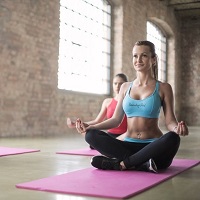
Yoga generally is a fantastic way of improving mental health. In his 2016 PhD study, Michael de Manincor, Psychologist, Founder and Director of The Yoga Institute (est. Australia 2000), noted the following from his research :
Those who practiced yoga for short periods on a regular basis experienced a 33% reduction in depression, a 26% reduction in anxiety and a 34% reduction in psychological distress. Overall mental health improved by 20%.
The study was carried out over a period of 6 weeks, with the participants practicing yoga for just 10-15 minutes, 3 or 4 times a week. Check out the video below to see Micheal de Manincour’s talk at the “Happiness and its Causes” seminar 2016 :
Mental health and our emotions are so closely linked and when we are unbalanced in these areas, energy blockages can constrict the flow of the life force, or prana. When we are experiencing mental and / or emotional stress it’s so important to make time for ourselves and to find an effective coping mechanism.
What’s Yin Yoga?
Slower, more meditative forms of yoga are ideal; generally speaking, the slower the pace, the deeper the stretches, leading in turn to deeper relaxation. Yin Yoga is an excellent example of a more restorative approach to yoga. It has it’s origins in China and India, dating back to about 2,000 years ago. More recently, it was introduced to the West in the 1970s by Paulie Zink, a martial arts champion and Taoist.
There are 3 principles of Yin Yoga…
1- Find your edge
Respect your body and find the intensity level that’s right for you without straining or pushing yourself too hard.
2 – Be still during the pose
Muscles should be soft in order for the joints and connective tissue to gain maximum benefit. By working with gravity, you sink into the poses and use props to support particular parts of the body.
3 – Hold the pose
By holding for extended periods, the life force energy can be absorbed deeper into the body. For beginners this may mean holding each asana for a minute at a time, or upto 10 minutes if you’re at advanced level. On average though the poses are held for 3-5 minutes each. A session can last from about 20 minutes to an hour or more.
There are 20 main Yin Yoga poses but they do not follow a particular pattern or sequence, and not all of them will be practiced in a single session. Yin is a great way to ease yourself into yoga as a beginner and can be particularly beneficial for lower back problems.
When I first tried Yin Yoga I found it a little slow. I’m usually always on the move – either mentally or physically or both, so the biggest challenge for me initially was to slow down and take my time with the poses. Add to that I had an 8 year old climbing all over me and shouting “boring” when the poses weren’t moving quick enough for her.
I soon realised she wasn’t there to “do yoga with mummy.” Her sole purpose was to hinder my progress so I sensibly decided to carry out further practice when my yoga partner was at school. Once again solo, it took a little time to get used to the pace, but once I did it was well worth it.
I was also surprised at how the feeling and effect of the poses changed from about 1 minute onwards. Again it took a little getting used to and there was an element of trial and error involved until I found the right level for me which was sufficiently challenging without me pushing myself too hard.
For me, the beauty of Yin Yoga is that it makes you slow down and it’s a great way to unwind and detach yourself from all that’s going on – even if only for a short time.
The Best Yoga For Spiritual Growth
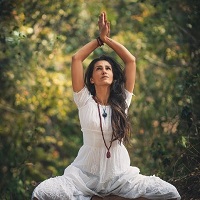
Of the aspects of holistic health, spirituality is possibly the hardest to define. Our physical selves are tangible, our thoughts and emotions can be measured, but what about spirituality? In simple terms spiritual growth might involve us learning how to be a better person – by developing compassion and selflessness, by carrying out random acts of kindness, by being more considerate.
On a deeper level, spiritual advancement may mean understanding our purpose in this life, truly feeling an energetic connection to all that is, achieving a higher state of consciousness and devoting ourselves completely and faithfully to the divine energy on the path towards enlightenment. We are all at different stages of our journey and our journeys themselves are all so different. One of the most important things to remember is that spirituality is a path available to everyone – regardless of religious beliefs.
What’s Kundalini Yoga?
The first reference to Kundalini energy dates back to about 3,000 years ago. The energy itself remains coiled at the base of the spine until it’s awakened. With the aim of enhancing spiritual growth and enlightenment, it can be awakened by different methods including regular spiritual practice, meditation, Kundalini Reiki and Kundalini Yoga.
There are some concerns over the safety of Kundalini awakening. See my article What Is Kundalini Reiki for more on this subject and for further reading recommendations.
The concept of Kundalini Yoga was bought to the West in 1968 by Harbhajan Singh Khalsa, a yogi and spiritual teacher who became a Kundalini Yoga Master at just 16 years of age. Kundalini Yoga is also known as the Yoga of Awareness. Although classes will differ, you can generally expect a session to begin with some breathing exercises and chanting.
Usually the Sat Nam mantra will open the session and may be chanted throughout. “Sat” means truth and “Nam” means identity, so this can be roughly translated as meaning “the real me.” All those in the class chant together.
I did a Kundalini session online and thought I would feel a bit of an idiot chanting – even though I was in the comfort of my own home – but…it felt really good. After the first couple of Sat Nams I didn’t care what the neighbours thought. The vibrations from chanting reach us on a cellular level and I felt really focused and centred. I’ve not experienced this before. It was a strange but wonderful surprise.
During the class a number of “Kriyas” are carried out. A Kriya is a sequence of practices including breathing techniques, chanting and postures. Each Kriya has a specific purpose such as to detoxify or energise. One of the breathing exercises is “breath of fire.” This involves very quick in and out breaths through the nose. As much as I enjoyed the chanting, this breathing technique turned me off completely. It felt so unnatural and I just didn’t like it.
When carried out correctly, the technique is said to bring about a higher state of consciousness, positivity, focus and expansion of the mind – which are the aims of Kundalini Yoga as a whole. I must have been doing it completely wrong as I felt none of these from the Breath of Fire. Also, I found some of the poses a little challenging – again at beginner level – but I did feel the physical benefits afterwards; my muscles felt good. The session usually ends with some more chanting (yay!) and meditation.
Maybe I’ll give it another try sometime, but for now, Kundalini Yoga is not for me. No doubt if I persevered I’d gain a lot more from it, but for me right now, spiritual progression isn’t my top priority. I’m happy with the level I’m at for now, but if enlightenment is your goal, why not give it a try?
Conclusion
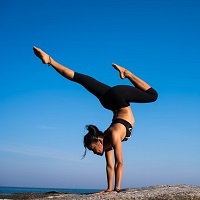
The purpose of this article is to give you a good understanding of some of the better-known styles of yoga in the Western world today and an idea of what to expect from the classes. These may or may not be the best style for you personally, and as such there is no “best yoga” as in one size fits all. What’s important to understand is that all of the above styles have physical, mental, emotional and spiritual benefits. We are all different and yoga should be a very personal thing.
There is a yoga out there for everyone, and I hope you are a step or two closer to finding the right style for you. After trying out a number of different yogas online, I’ve realised that I need to start at the most basic beginner level possible as my fitness levels are considerably lower than I first thought.
I’ve made the decision to commit to yoga – to make it part of my everyday life. As I’m the wrong side of 45, I’ve decided I want to reach 50 in a state of fitness, health and inner calm. My plan is to start low and build it up slow in order to achieve balance in all areas of my life.
Oh yeah, and I also really want to do some of the super difficult poses…how cool would that be! For now though, a small step at a time.
If you’ve enjoyed reading this, or if you would like to share your experiences with yoga, please leave a comment or contact me on jane@therapyjet.net.
Namaste




